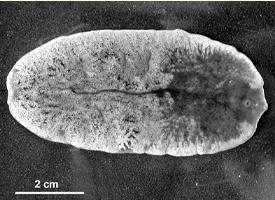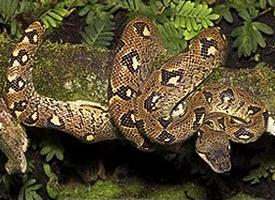
Súlyok és méretek
| Hossz | 4-tól 8-ig cm |
|---|
Állatleírás
The Giant Liver Fluke, scientifically named Fascioloides magna, is a large, parasitic flatworm belonging to the class Trematoda. This parasite is particularly notorious for infecting the livers of various wild and domestic ruminants, including deer, elk, moose, cattle, and sheep. Fascioloides magna has a complex life cycle that involves multiple hosts and environments, showcasing its adaptability and resilience in nature.Adult Fascioloides magna can reach substantial sizes, typically measuring between 3 to 10 centimeters in length, which is considerably larger than many other fluke species. Their bodies are flat, leaf-like in shape, and exhibit a dull brown color, which helps them blend into the liver tissues of their hosts. The adult flukes reside in the liver's bile ducts, where they feed on the host's blood, causing significant damage to the liver tissues and impairing the organ's function.
The life cycle of the Giant Liver Fluke begins when its eggs are excreted in the feces of an infected host. Upon reaching a freshwater environment, the eggs hatch into free-swimming larvae, known as miracidia. These larvae must find and infect a specific type of aquatic snail to continue their development. Within the snail, the miracidia undergo several developmental stages, eventually emerging as cercariae, another type of free-swimming larval stage. The cercariae leave the snail and encyst on aquatic vegetation as metacercariae, which are the infective stage for the final host.
When ruminants consume vegetation contaminated with metacercariae, the lifecycle progresses. The metacercariae excyst in the small intestine and migrate to the liver, where they mature into adult flukes. This migration and the presence of the flukes cause significant damage to the liver, leading to a condition known as fascioloidosis. The severity of the disease depends on the number of flukes present and can range from mild, showing few clinical signs, to severe, resulting in weight loss, decreased milk production, liver failure, and potentially death.
The Giant Liver Fluke's lifecycle highlights its dependence on specific environmental conditions and hosts for survival. It also underscores the challenges in controlling its spread, particularly in areas where wildlife and livestock share grazing lands. Management and prevention of fascioloidosis involve controlling snail populations, preventing livestock from grazing in high-risk areas, and the strategic use of antiparasitic treatments.
In conclusion, Fascioloides magna is a fascinating yet problematic parasite that poses significant health risks to ruminant populations. Its ability to navigate complex life cycles and adapt to various hosts and environments makes it a formidable pathogen in the ecosystems it inhabits.
Hasonló állatok
Új állatfotók
Top 10 állat
- Dolphin gull (Leucophaeus scoresbii)
- Diana monkey (Cercopithecus diana)
- Moustached guenon (Cercopithecus cephus)
- Galápagos tortoise (Geochelone nigra complex)
- Japanese macaque (Macaca fuscata)
- Russian tortoise (Testudo horsfieldii)
- Stone loach (Barbatula barbatula)
- Greek tortoise (Testudo graeca)
- Common flying dragon (Draco volans)
- Vendace (Coregonus albula)


